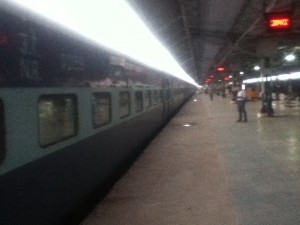By TIM ROSENKRANZ, 7/11/2014. Taking the Indian Railway is a fantastic experience! I have to say this, even though the train I took from Delhi to Agra for my 2.5 hour journey was actually quite a boring business train. Equipped with mostly higher class “chair cars,” it had neither the almost iconic overcrowded commuter cars, nor the luxury cabins. But the amount of service from newspaper selection, water, tea to breakfast that was cramped into the short travel time was truly amazing. A well-choreographed dance of service personal for hundreds of people on one train. All this for a less than $20.
Indians have a love-hate-relationship with their railway. They complain about the service, the overcrowding, the problems with bookings, the delays. But somehow the railway is also a source of pride, as it is one of the largest in the world. Last but not least the railway is an absolute necessity for hundreds of millions, who could without it neither commute to work, nor see their families. Because of this public necessity the Indian Railway is cheap, even by Indian standards. The railway is a true public good, shared and needed by most Indians if rich or poor.
It is a mere coincidence that I was on the train, only a day after the railway minister of Narendra Modi’s new government announced a new budget, that combined steep fare hikes with a plan to open the railway to public-private partnership and Foreign Direct Investment (FDI). To be fair, many points in the budget addressing safety, updated infrastructure, better electronic signaling and online booking systems are more than necessary for a railway system of this scale. But hailed by India’s business press as “break from populism,” the railway budget exemplifies Modi’s messianic believe in outside investment, combined with austerity measures on the backs of the larger public.
Of course tourists, high-end leisure travelers and business commuters could and should probably pay more towards the railway. But the illusion of running a deficit-free, high-speed, cost-effective railway, which is the final goal of this budget, will leave a lot of people on the platforms. Putting bullet trains over economic accessibility is the choice for flashy, capital attracting projects over daily necessity of millions of citizens. This budget will probably be only the first step into “New India’s” future.

